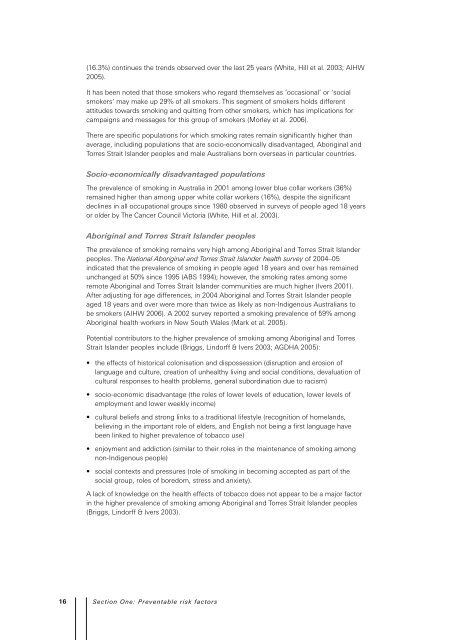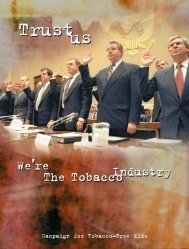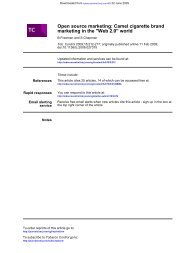National Cancer Prevention Policy - Tobacco Control Supersite
National Cancer Prevention Policy - Tobacco Control Supersite
National Cancer Prevention Policy - Tobacco Control Supersite
You also want an ePaper? Increase the reach of your titles
YUMPU automatically turns print PDFs into web optimized ePapers that Google loves.
(16.3%) continues the trends observed over the last 25 years (White, Hill et al. 2003; AIHW<br />
2005).<br />
It has been noted that those smokers who regard themselves as ‘occasional’ or ‘social<br />
smokers’ may make up 29% of all smokers. This segment of smokers holds different<br />
attitudes towards smoking and quitting from other smokers, which has implications for<br />
campaigns and messages for this group of smokers (Morley et al. 2006).<br />
There are specific populations for which smoking rates remain significantly higher than<br />
average, including populations that are socio-economically disadvantaged, Aboriginal and<br />
Torres Strait Islander peoples and male Australians born overseas in particular countries.<br />
Socio-economically disadvantaged populations<br />
The prevalence of smoking in Australia in 2001 among lower blue collar workers (36%)<br />
remained higher than among upper white collar workers (16%), despite the significant<br />
declines in all occupational groups since 1980 observed in surveys of people aged 18 years<br />
or older by The <strong>Cancer</strong> Council Victoria (White, Hill et al. 2003).<br />
Aboriginal and Torres Strait Islander peoples<br />
The prevalence of smoking remains very high among Aboriginal and Torres Strait Islander<br />
peoples. The <strong>National</strong> Aboriginal and Torres Strait Islander health survey of 2004–05<br />
indicated that the prevalence of smoking in people aged 18 years and over has remained<br />
unchanged at 50% since 1995 (ABS 1994); however, the smoking rates among some<br />
remote Aboriginal and Torres Strait Islander communities are much higher (Ivers 2001).<br />
After adjusting for age differences, in 2004 Aboriginal and Torres Strait Islander people<br />
aged 18 years and over were more than twice as likely as non-Indigenous Australians to<br />
be smokers (AIHW 2006). A 2002 survey reported a smoking prevalence of 59% among<br />
Aboriginal health workers in New South Wales (Mark et al. 2005).<br />
Potential contributors to the higher prevalence of smoking among Aboriginal and Torres<br />
Strait Islander peoples include (Briggs, Lindorff & Ivers 2003; AGDHA 2005):<br />
•<br />
•<br />
•<br />
•<br />
•<br />
the effects of historical colonisation and dispossession (disruption and erosion of<br />
language and culture, creation of unhealthy living and social conditions, devaluation of<br />
cultural responses to health problems, general subordination due to racism)<br />
socio-economic disadvantage (the roles of lower levels of education, lower levels of<br />
employment and lower weekly income)<br />
cultural beliefs and strong links to a traditional lifestyle (recognition of homelands,<br />
believing in the important role of elders, and English not being a first language have<br />
been linked to higher prevalence of tobacco use)<br />
enjoyment and addiction (similar to their roles in the maintenance of smoking among<br />
non-Indigenous people)<br />
social contexts and pressures (role of smoking in becoming accepted as part of the<br />
social group, roles of boredom, stress and anxiety).<br />
A lack of knowledge on the health effects of tobacco does not appear to be a major factor<br />
in the higher prevalence of smoking among Aboriginal and Torres Strait Islander peoples<br />
(Briggs, Lindorff & Ivers 2003).<br />
1 Section One: Preventable risk factors




